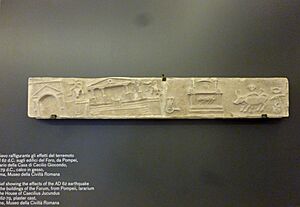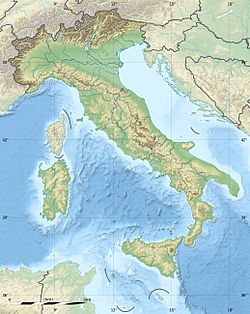AD 62 Pompeii earthquake facts for kids
| Local date | 5 February 62 |
|---|---|
| Magnitude | 5.2–6.1 |
| Epicentre | 40°42′N 14°30′E / 40.7°N 14.5°E |
| Areas affected | Roman Empire, Campania |
| Max. intensity | IX (Violent) – X (Extreme) |
On 5 February AD 62, a powerful earthquake shook the ancient towns of Pompeii and Herculaneum. It caused a lot of damage to these cities. This earthquake might have been an early warning sign for the famous eruption of Mount Vesuvius in AD 79. That later eruption completely buried and destroyed both towns. A famous Roman writer and thinker named Seneca the Younger wrote about this earthquake. He described it in his book called Naturales quaestiones.
Contents
Why Earthquakes Happen Here
The earthquake's starting point was near Mount Vesuvius. This area has many active "faults." Faults are like giant cracks in the Earth's crust. When these cracks move, they cause earthquakes.
These faults are part of a bigger system. This system stretches along the Apennines mountains. It is linked to the slow opening of the Tyrrhenian Sea. Some experts think that earthquakes in this region might be connected to Vesuvius erupting. However, this idea is not yet fully proven.
When Did It Happen?
There is some debate about the exact year of this earthquake. Seneca the Younger, who wrote about it soon after, said it happened in AD 63. But another Roman historian, Tacitus, wrote about 40 years later. He said it happened in AD 62.
Today, most experts believe AD 62 is the correct date. This is based on looking at different historical records.
How Strong Was It?
Scientists estimate the earthquake's strength based on the damage it caused. Its magnitude was likely between 5 and 6.1. This means it was a very strong earthquake. The shaking was most intense in Pompeii and Herculaneum. It was so strong that it reached levels IX to X on the Mercalli scale. This scale measures how much people feel an earthquake and the damage it causes.
People reported that the ground kept shaking for several days. These smaller shakes are called aftershocks. The earthquake started about 5 to 6 kilometers (3-4 miles) deep inside the Earth.
This earthquake was probably a sign that Vesuvius was waking up. The volcano had been quiet for a very long time before its big eruption in AD 79.
Damage Caused by the Earthquake

The towns of Pompeii and Herculaneum suffered a lot of damage. Some buildings in nearby Naples and Nuceria (modern Nocera Inferiore) were also damaged. Seneca wrote that 600 sheep died. He thought they died from poisonous gases released during the earthquake.
In Pompeii, there was a house called the House of Lucius Caecilius Iucundus. This house had special stone carvings, called bas-reliefs. These carvings showed the damage to the city and its Temple of Jupiter during the AD 62 earthquake. The owner of the house, Lucius Caecilius Iucundus, might have died during the earthquake.
What Happened After?
People in Pompeii and Herculaneum started repairing the damage. They worked hard to rebuild their towns. Many repairs were finished by the time Vesuvius erupted in AD 79.
The stone carvings from the House of Lucius Caecilius Iucundus show the earthquake's effects. They show damage to important buildings like the Temple of Jupiter. They also show the Aquarium of Caesar and the Vesuvius Gate.
The earthquake also inspired Seneca the Younger. He was a Roman philosopher and writer. He wrote a whole book about earthquakes. In it, he described the AD 62 event. He also shared his ideas about what causes earthquakes.
See also
- List of earthquakes in Italy
- List of historical earthquakes


